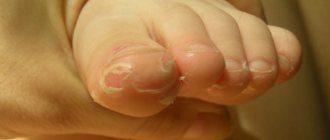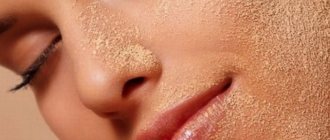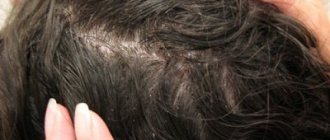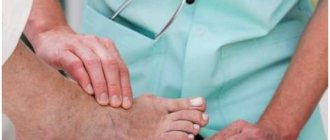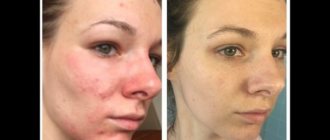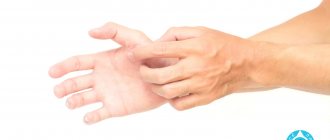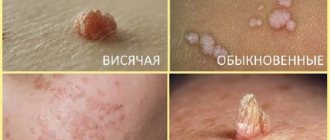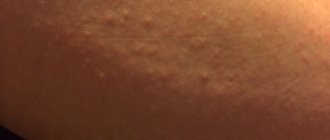Weeping dermatitis is one of the types of skin diseases that develops under the influence of negative external or internal factors on the epidermal tissue. In most cases, weeping of the skin occurs after pathogens of streptococcal infection enter the dermis. Weeping dermatitis is distinguished by the fact that the surface of the affected skin is in a constant state of inflammation, wet to the touch, and over time becomes covered with ulcerative formations with the release of purulent contents. Based on its location, this disease can occur on any part of the body, but most often occurs in folds and places where the skin is poorly ventilated.
What is weeping
Weeping is a weeping area on the skin that occurs as a result of an abnormal process, which is expressed in the exudation (secretion) of serous, bloody or purulent fluid (exudate) through small erosions (damages) of the epidermis (the upper layer of the skin). Weeping is not a disease, it is a sign of a pathological process occurring in a separate area of the skin or a symptom of internal disorders and dermatological diseases.
Serous exudate looks like a transparent whitish liquid containing proteins, leukocytes (white blood cells), breakdown products, and toxins.
The leading factors in the manifestation of weeping erosions due to exudation are considered to be:
- increased permeability of blood vessels (capillaries, venules - small veins) as a result of inflammation or aggression of allergens;
- as well as an increase in pressure in the vessels of affected tissues due to hyperemia (overflow of blood).
Weeping behind the ears of a child (photo)
When to see a doctor
In medicine, there are pathological conditions associated with a weeping wound that require immediate medical attention. These include the following cases:
- Dark spots with unclear boundaries appeared around the damaged area.
- The defect is located near a large lymph node.
- Purulent contents with an unpleasant pungent odor began to ooze from the surface. Indicates the development of septic blood poisoning.
- A weeping wound on the face needs specialist consultation.
- The pathological area has increased significantly in size. There is pronounced tissue swelling.
- The disease attacks the entire body. The patient develops chills, high body temperature, severe weakness, and lethargy.
- The fluid is released profusely; the dressings have to be changed 4–5 times a day.
These complications require adjustments in treatment by the doctor and the prescription of certain medications and remedies.
Peeling off crusts and films is strictly prohibited. You need to consult your doctor.
How to identify it in yourself
It is quite easy to identify your own weeping. In the area of skin damage, against a background of inflammation, swelling, and redness, multiple pinpoint lesions (erosions) covered with moisture are visible. The skin looks wet and shiny.
This phenomenon is observed in the following conditions:
- inflammation (viral, bacterial, fungal nature);
- opening of vesicles (vesicles, blisters);
- intense scratching;
- superficial and deep wounds, ulcers;
- burns, frostbite.
Features of the pathological process
Incorrect treatment, the development of an allergic reaction to drug components, the addition of a bacterial infection, and poor hygiene lead to the development of unpleasant complications. Features of the pathological process associated with a weeping wound are as follows:
- The wound does not heal, it gets wet and itches. The absence of positive changes in the treatment of prescribed drugs indicates incorrectly selected therapy. The condition requires medical intervention and the appointment of more appropriate therapy.
- Redness and swelling of the edges of the defect appear.
- The formation of a crust does not guarantee healing. There may continue to be pus underneath. The condition threatens the development of sepsis.
- Additional sores or blisters with fluid may form around the damaged area. They may indicate the onset of an allergic reaction or the addition of pathogenic flora.
A distinctive feature of such defects is the mechanism of their occurrence. A weeping wound is formed as a result of mechanical damage: a strong blow, compression, bruise. The plasma that comes out is responsible for the appearance of the ichor. Ulcers occur due to improper metabolism, disruption of tissue trophism, for example, with diabetes mellitus or vascular ischemia of the lower extremities.
What disorders may this symptom indicate?
In the vast majority of cases, weeping as a symptom is characteristic of the following diseases:
- atopic, weeping dermatitis, all types of itchy dermatitis;
- exudative psoriasis;
- versicolor - eczema;
- blistering dermatoses, including pemphigus, bullous pemphigoid, epidermolysis;
- contagious (wetting) impetigo;
- bedsores and diaper rash;
- trophic ulcers;
- serous or purulent omphalitis (“weeping navel”) in infants - a pathology with characteristic exudate from the umbilical wound and slow healing;
- weeping hemorrhoids (III – IV stage of the disease);
- burns and frostbite;
- chicken pox;
- purulent skin lesions, including: diffuse and ulcerative streptoderma (ecthyma), intertriginous streptoderma (streptococcal intertrigo).
Diagnostics
When a patient contacts a dermatologist, the diagnosis is established during the first examination. Sometimes, thanks to a thorough interview, it is possible to establish the cause of the disease.
First of all, a specialist will suspect eczema. However, with it, the inflammatory process develops in the uppermost layer of the skin (epidermis), and with weeping dermatitis - in the deeper parts.
Further, the survey method will exclude professional and household hazards, the presence of allergies, and digestive diseases.
If this is not enough to determine the cause of the development of weeping skin, then additional examination will be carried out. During this process, the blood is examined for antibodies to sexually transmitted diseases, to determine the level of hemoglobin and leukocytes, and to identify changes in the functioning of the liver and pancreas. If necessary, an ultrasound of the abdominal organs and a consultation with a neurologist are prescribed.
A smear must be taken from the surface of the skin to examine the material under a microscope or culture it to determine the pathogenic agent.
Therapy for weeping skin elements is almost always complex and complex. It begins only after the cause has been identified and eliminated, which is not always possible (for example, with HIV).
In all cases, it is necessary to normalize nutrition, follow a special diet, and follow hygienic standards for skin care.
Drug treatment is used according to indications. So, if there is severe skin itching, then antihistamines (cetirizine, loratadine, suprastin, tavegil) are prescribed. For infections, antibiotics or antimycotic drugs are used. Sometimes various hormonal agents are also necessary. Drugs are required to increase the body's resistance.
Various ointments and disinfectant solutions, as well as folk remedies (oak bark decoction, chamomile infusion) are used locally. Some physiotherapeutic procedures also have a good effect.
In any case, treatment of weeping dermatitis should occur exclusively against the background of therapy for the underlying disease.
How to deal with this symptom
Since weeping is a symptom phenomenon, complete relief from it is possible by curing the causative disease in which this symptom occurs. Thus, with weeping eczema, therapy aimed at eliminating neurotic disorders and neuroendocrine disorders will also affect the external signs of the disease, including weeping.
Local preparations that are used externally can significantly reduce the severity of this unpleasant manifestation, reduce tissue inflammation and the intensity of exudate, dry the wound area, relieve itching and burning.
Important! The use of any drug requires mandatory review of the instructions and agreement with the doctor, since the choice of a specific gel, emulsion, solution depends on the type of disease. A medicine recommended for weeping caused by one pathology may be prohibited for another disease.
General recommendations
Weeping or vesicles (bubbles) with exudate usually indicate the acute stage of the disease, when the skin is easily infected, primarily by staphylococci and streptococcal flora.
Many experts insist that at the stage of fluid secretion, one should not use anti-inflammatory fatty ointments, which can worsen the condition of the affected areas, but only creams and emulsions that do not interfere with the evaporation of moisture. In case of severe exudation against the background of various skin lesions, zinc-based drying and astringent agents, creams and emulsions, lotions and wet-dry dressings with medicinal solutions, non-steroidal and serious hormonal ointments with anti-exudative action are used.
This video will tell you how to treat and how to treat weeping with atopic dermatitis:
Lotions
One of the simple and effective ways to soften weeping acute inflammatory processes (dermatitis, eczema) is cold lotions and wet-drying with medicinal solutions. The mechanism of action is based on the evaporation of water, cooling the skin, astringent and drying effect. When the skin cools, the blood vessels in the affected weeping area constrict, which leads to a decrease in the severity of weeping and inflammation.
For lotions use:
- Burov's liquid (1 teaspoon per 200 ml of water);
- boric acid 2%;
- silver nitrate 0.025%;
- tannin solution 4%;
- Dimexide solution (including erysipelas, eczema, deep burns) 25 – 90%;
- Resorcinol 1%.
Experts often advise that in case of “wet” skin changes, make lotions not with alcohol, so as not to dry out or burn the damaged skin, but with water or saline solution. The most gentle effects have:
- furatsilin (1 tablet per 200 ml of water);
- solution of potassium permanganate (potassium permanganate 0.05%) pale pink;
- decoctions with oak bark, black currant leaves, tricolor violet, chamomile, birch buds, sage, bay leaf, coltsfoot herb;
- weak brew of black tea;
- mumiyo solution (3 grams per glass of water).
It is advisable to keep the lotion solution in the refrigerator. A wide bandage folded in several layers is moistened in it, wrung out very well, and applied to the affected area. As soon as the lotion begins to warm up (after 5 minutes), the procedure is repeated with a cool solution. Duration – up to one and a half hours, twice a day.
For the bandage, use up to 12 layers of gauze, put a little absorbent cotton wool (natural) on top, secure it loosely with a bandage and change it after 1 to 3 hours as it dries. Bandages act similar to lotions, but are less effective.
Important! Do not allow the lotions to become warm, as this may increase exudation and inflammation.
Separately, it should be said about weeping hemorrhoids. To reduce weeping in the anal area, lotions and baths with knotweed, chamomile, burdock root, oak bark, eucalyptus, and rowan are used. Add mumiyo, garlic juice, onion peel decoction, propolis, birch tar and sea buckthorn oil.
Wetting of the skin on the back of the hands
Drugs for inflammatory processes with exudation
In the combined treatment of weeping areas, in addition to lotions, external agents of varying degrees of effectiveness are used.
External medications that help with weeping:
| A drug | Pathologies |
| Desitin cream |
Especially recommended for young patients due to the minimum of side effects |
| Tsindol, chatterbox | |
| Zinc paste | |
| "Ambulance". Natural powder | Drying agent for various injuries with weeping. Anti-inflammatory, disinfectant, healing effect |
| Baneocin powder |
|
| Powder and powder Xeroform |
Low toxicity, non-irritating, minimal adverse reactions |
| Fukortsin | Use with caution to avoid drying and burning the skin. Possible severe burning sensation. |
| Methylene blue | |
| Brilliant green (“zelenka”) | |
| Elidel (stronger analogue - Protopic) | Atopic dermatitis, weeping eczema (except microbial) |
| Elokom cream, lotion; Momat cream |
Use caution in children and large affected areas |
| Hormonal agents | |
| Sinaflan liniment (highly active glucocorticosteroid) | “Wet” dermatitis, eczema, diaper rash and bedsores with exudate, exudative forms of erythema, psoriasis |
| Advantan, emulsion (highly active) | Used for acute and chronic dermatitis, eczema accompanied by exudation. Suppresses inflammatory reactions associated with increased exudation, leading to a reduction in weeping, itching, pain, and irritation |
| Afloderm cream (moderate activity) | In particularly sensitive areas (face, chest, genitals). Allowed for children from 6 months, nursing and pregnant women |
| Flucinar gel (highly active) | For “wet” eczema and dermatitis with weeping |
| Lokoid Crelo, emulsion (low-active), Lokoid cream | Weeping areas in various skin pathologies |
Active non-hormonal agents for severe erosion
For weeping lesions on the skin, it should be borne in mind that symptom treatment is carried out in stages, taking into account the stages of the pathological process in these areas. First, dry it, then protect it.
Strong non-steroidal drugs:
- Stellanin PEG ointment. Stellanin PEG with antimicrobial, regenerating and anti-inflammatory effects, unlike Stellanin ointment, is used specifically for weeping skin pathologies associated with infection:
- trophic weeping ulcers, bedsores;
- weeping areas due to burns;
- severe scratching after insect bites.
- Gel Solcoseryl. It is the medicinal form of Solcoseryl in the form of a fat-free gel that reduces and prevents exudation and wetting of wound areas, and stimulates the formation of collagen fibers.
If the exudate ceases to be released and the process of “drying” occurs, you can begin to use ointments Solcoseryl, Stellanin, Actovegin, which create a protective film.
ethnoscience
You can smear the wet area with a self-made lime ointment: the same volume of water per 100 g of quenched lime. The mixture is brought to a boil, left to cool until completely cooled, filtered and mixed with vegetable oil in equal quantities. When taking a bath, you can add essential oils of tea tree, lavender or geranium to the water.
Vesicles
The first signs of weeping are the formation of small red bubbles on the skin - in a group or one at a time. A vesicle is a hemispherical blistering rash, the size of a pinhead to the size of an average pea. A serous fluid accumulates inside - clear or slightly cloudy, sometimes with blood. Blisters periodically burst, erosion forms in their place, it dries out and becomes crusty.
Weeping dermatitis is a skin pathology that develops under the influence of negative external factors or problems in the functioning of organs. Most often, weeping occurs when a streptococcal infection penetrates the dermis.
A weeping wound is mechanical damage to healthy tissue, which is manifested by the release of a specific fluid - ichor. This means a violation of the integrity of the skin with the formation of pathological contents of a transparent yellowish tint.
Under the influence of negative factors, abrasions and ulcers form on the skin. Normally, local immunity copes with the problem on its own. The resulting defect heals in 1–2 weeks, depending on the size of the damaged surface. When the body's defenses weaken, the wound healing period increases. She's starting to get damp.
A distinctive feature of such defects is the mechanism of their occurrence. A weeping wound is formed as a result of mechanical damage: a strong blow, compression, bruise. The plasma that comes out is responsible for the appearance of the ichor. Ulcers occur due to improper metabolism, disruption of tissue trophism, for example, with diabetes mellitus or vascular ischemia of the lower extremities.
The main sources of the appearance of a pathological focus can be:
- Mosquito bites followed by scratching
- Dermatological diseases that are accompanied by intense itching and burning.
- Skin irritation from diapers.
- Calluses, fresh abrasions on the feet.
- Burns, including moderate and severe burns, which occupy large areas of the body.
- Non-healing, weeping wounds after surgery that occur when sutures are removed incorrectly.
The appearance is promoted by bacterial infection. Pathogenic microorganisms form a pathological focus when the rules of asepsis/antiseptics, personal hygiene rules are violated, or incorrect or late treatment.
Why does my skin get wet?
Weeping skin in most cases is a symptom of various diseases in which pathological changes occur throughout the body. Let's list the main ones:
- diseases of the digestive system;
- allergies – food, medication, cosmetics, household chemicals, etc.;
- stress, neurosis, depression;
- occupational diseases among chemical industry workers;
- toxic effects of various chemicals;
- chronic alcoholism;
- HIV;
- drug addiction or substance abuse;
- diabetes.
Weeping skin does not always accompany these pathologies. The impetus for its appearance can be the following factors:
- failure to comply with hygiene rules;
- unsanitary environmental conditions;
- general decrease in immunity;
- poor nutrition.
Prevention
You can avoid the appearance of signs of weeping skin if you follow certain conditions:
- treat chronic diseases in a timely manner;
- undergo regular medical examinations;
- avoid nervous tension;
- observe the rules of hygiene;
- strengthen immunity;
- Healthy food;
- do not contact with allergens;
- fight bad habits.
In case of acute weeping dermatitis and timely contact with specialists, as a rule, treatment is quite effective. When the process becomes chronic, especially in combination with alcoholism, drug addiction or HIV, the prognosis is unfavorable. In this case, therapy gives only temporary results.
Was the page useful? Share it on your favorite social network!
Eczema is a chronic, skin, non-contagious, inflammatory disease characterized by rashes, itching, periods of exacerbation and remission (improvement).
Another name for eczema is tinea versicolor. Translated from ekzeo - to boil, this explains the property of bubbles to quickly open, like bubbles of boiling water.
The disease itself is widespread.
There are two forms of eczema: acute and chronic.
There are the following types of eczema:
- The true (idiopathic) form is characterized by an acute onset of the disease. The lesion is symmetrical (most often the hands are involved, but can be located anywhere), the boundaries are unclear. Foci of redness are noted, against which vesicles (bubbles), papules (nodules) form, the skin is swollen; after some time, the blisters open, forming erosions (skin defect), serous contents are released (called eczematous wells) - this condition is called oozing, then the contents dry out and serous (if the contents are serous) or hemorrhagic (i.e. bloody) crusts are formed.
- Microbial eczema develops at the site of chronic foci of infection; when an infection is attached, the following subtypes can be distinguished.
Mycotic form - when a fungal component is attached, peeling occurs.
Paratraumatic form - rashes are located at the site of injury.
Varicose form - against the background of trophic disorders, most often located on the legs, rashes of a bluish-purple color, located asymmetrically.
Numular (coin-shaped) - bluish-pinkish rashes, with vesicles, papules, weeping, diameter 1.5-3 cm.
Dyshidrotic eczema - localized on the palms, soles, and lateral surfaces of the fingers, characterized by swelling, weeping, blisters, and nodules.
- Seborrheic eczema develops in patients with seborrhea in areas of the skin rich in sebaceous glands (scalp, ears, navel, chest, between the shoulder blades, between the buttocks, elements in the form of flaky spots against a background of redness.
- Occupational eczema occurs mainly on exposed parts of the skin as a result of exposure to occupational hazards; the diagnosis is made by an occupational pathologist. Each new exacerbation is stronger and more severe, longer. When the cause is eliminated, improvement is noted.
- Eczema in children is characterized by the severity of the exudative component and an abundance of rashes. The skin of the face is affected (only the skin around the mouth remains free from rashes). Tendency to infection.
- Tilotic (callous) like dyshidrotic, elements are localized on the palms and soles, the stratum corneum (surface) thickens, areas of hyperkeratosis form in the form of calluses in place of vesicular elements.
A certain pathological process or dermatological disease is characterized by a certain type of rash and localization. In any case, if a red spot appears on the skin, you should consult a doctor rather than try to eliminate the symptom yourself.

